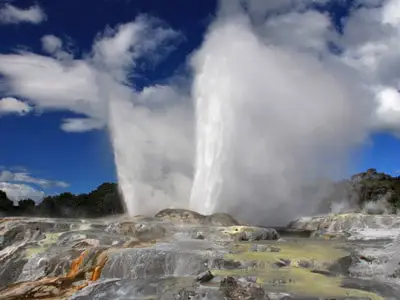Geothermal Energy
Geothermal energy represents the energy that comes from the inside Earth in the form of heat. It is the result of transfer of features of water makes its way to the surface and how heat interacts with the Earth’s interior areas. What results in the end, are steam and hot water. These are then captured through geothermal power, high power and used to heat homes and various others.
Under the name of exploitable geothermal energy, there are two sources of energy:
- The earth’s hot core energy transmitted by conduction, its upper layers;
- Solar radiation transmitted through the earth and stored in its bedding surface.

There are both some advantages and disadvantages of geothermal energy which are described below.
Advantages of Geothermal Energy
Earth’s temperature increases considerably with near its center. In some areas of the planet, in deep water is found at very high temperatures. Geothermal high temperature (150° -300°C) involves pumping the water to the surface, where, by means of heat exchangers, steam is formed, which are then used in the turbine, as in the case of conventional thermal power stations and so produce electricity. The advantages of Geothermal energy are –
- The resulting energy is environmentally clean. Unlike the use of nuclear power and fossil fuels or oil, this kind of energy it’s almost 100% clean.
- Geothermal power plants are unaffected by weather and night cycle/day. Unlike solar panels that use solar energy, which is currently dependent on the sun and light.
- Geothermal energy is cheaper. It is more advantageous than the energy obtained on coals.
- Geothermal energy is renewable. Geothermal resources are huge and they will be for indefinite time.
- Applications are varied to geothermal heat. They include domestic heating (individual or even of entire cities), growing plants within greenhouses also drying crops and heating water within fish farms as well as in some industrial processes for instance pasteurization of milk.
Disadvantages of geothermal energy
As a brief history, geothermal hot springs have been used in past centuries for washing and heating homes, in 1904 the first recorded use in the production of electricity (a generator to power four light bulbs). From 1911 to 1958 there was only one geothermal power plant. The disadvantages of Geothermal energy are listed below.
- Limited life time. Geothermal activity areas are cooled after several decades of use, so we can not speak of an infinite source of energy.
- Increasing ground instability in the area, which can be caused by even low intensity earthquakes as a result of the different procedures used in pumping water.
- Geothermal energy is limited geographically. Only certain areas are likely to operate.
- Groundwater contamination can be a problem if the geothermal wells were not well sealed at great depths cement and steel tubes.
In conclusion, geothermal energy is one benefit to humanity and should be exploited to its full potential. Geothermal energy is an energy source that can be used indefinitely because of their long existence. The resulting pollution level is very small and by using this type of alternative energy we give to Earth a chance to live longer.


Nice